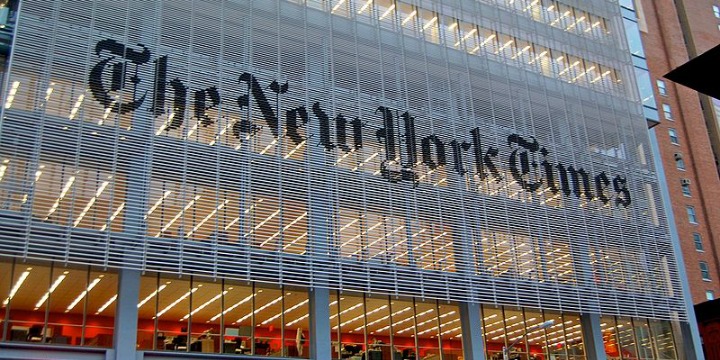 ‘Whitewashing a Pogrom’: Jews Assail New York Times for New Failure in Crown Heights Riot Recap
‘Whitewashing a Pogrom’: Jews Assail New York Times for New Failure in Crown Heights Riot Recap
Ira Stoll
 The headquarters of The New York Times. Photo: Wikimedia Commons.
The headquarters of The New York Times. Photo: Wikimedia Commons.
Jewish leaders are condemning as inaccurate a New York Times article describing the 1991 Crown Heights riot as turning streets into “combat zones, pitting groups of Hasidic Jews against mostly Black men.”
The passage came in a long article in Monday’s New York Times, a week before an election, that explored “How the Hasidic Jewish Community Became a Political Force in New York.” As usual for the Times, the article is by a non-Hasidic reporter, although the newspaper frequently strives to assign women, Black, Hispanic, and gay reporters to articles about the politics of those communities.
Why this is a story for the Times to explore at such length is a question in itself. Perhaps the Times is preparing its left-wing readers so that they have someone to blame (Hasidim!) if Republican Lee Zeldin beats Democratic Governor Kathy Hochul in the election. Or perhaps it is an outgrowth of the Times campaign against Jewish education, a campaign the newspaper has been waging at least since 2016.
Whatever the motive, what really irked Jewish readers was the recap of the Crown Heights riots, which the Times itself, by its own journalists’ later public admission, failed miserably to cover accurately back when it actually happened.
The October 31, 2022 Times article describes it this way:
The violence and chaos was almost unimaginable. Overnight, Brooklyn streets had turned into combat zones, pitting groups of Hasidic Jews against mostly Black men — some holding longstanding grudges over what they saw as the Hasidic community receiving preferential treatment from the police and the city. Racial and antisemitic epithets filled the air alongside hurled rocks and bottles.
A police-led motorcade of the Lubavitcher grand rebbe had fatally struck a Black child, and in the melees that followed, a visiting Australian Hasidic scholar was stabbed to death. Hasidic leaders in Brooklyn pleaded with city officials for more police intervention and protection, but the help did not come until days later.
Rabbi Mordechai Lightstone of the Crown Heights-based Chabad Lubavitch Hasidic group tweeted that the Times language was “absolutely bizarre” and “deeply problematic.”
An editor at the Wall Street Journal, Elliot Kaufman, wrote that the New York Times “is continuing its 30-year campaign of lies about the Crown Heights Riot.” Kaufman wrote that Yankel Rosenbaum “was killed by an anti-Semitic mob that set on him because he was an identifiable Jew. Does this sound like a ‘melee’ or clash ‘pitting groups of Hasidic Jews against mostly Black men’?”
An online news and opinion website sponsored by the conservative Heritage Foundation, The Daily Signal, ran an article about the situation headlined, “Jewish Leaders Condemn ‘Antisemitic’ New York Times Article for ‘Whitewashing’ a ‘Pogrom.’”
The author of the Times article, Emma G. Fitzsimmons, did not immediately respond to an email from The Algemeiner asking if she had a response to the criticism.
Times coverage of the riot has been a long-running sore point with Jewish readers. In 2011, Jeffrey Goldberg wrote in the Atlantic, “It is astonishing, the lengths the Times went to prove that a riot that was antisemitic on its face wasn’t, in fact, antisemitic.” Ari Goldman, who was working for the Times, later wrote in the Jewish Week, “I read an opening paragraph, what journalists call a ‘lead,’ that was simply untrue: ‘Hasidim and blacks clashed in the Crown Heights section of Brooklyn through the day and into the night yesterday.’ In all my reporting during the riots I never saw — or heard of — any violence by Jews against blacks. But the Times was dedicated to this version of events: blacks and Jews clashing amid racial tensions.”
A 2017 Times article essentially denied that Jews in Crown Heights even exist, describing the neighborhood as “a largely West Indian and African-American community.”
Thirty years after the riot, the Times still can’t get the story right.
Ira Stoll was managing editor of The Forward and North American editor of The Jerusalem Post. His media critique, a regular Algemeiner feature, can be found here.
Zawartość publikowanych artykułów i materiałów nie reprezentuje poglądów ani opinii Reunion’68,
ani też webmastera Blogu Reunion’68, chyba ze jest to wyraźnie zaznaczone.
Twoje uwagi, linki, własne artykuły lub wiadomości prześlij na adres:
webmaster@reunion68.com
